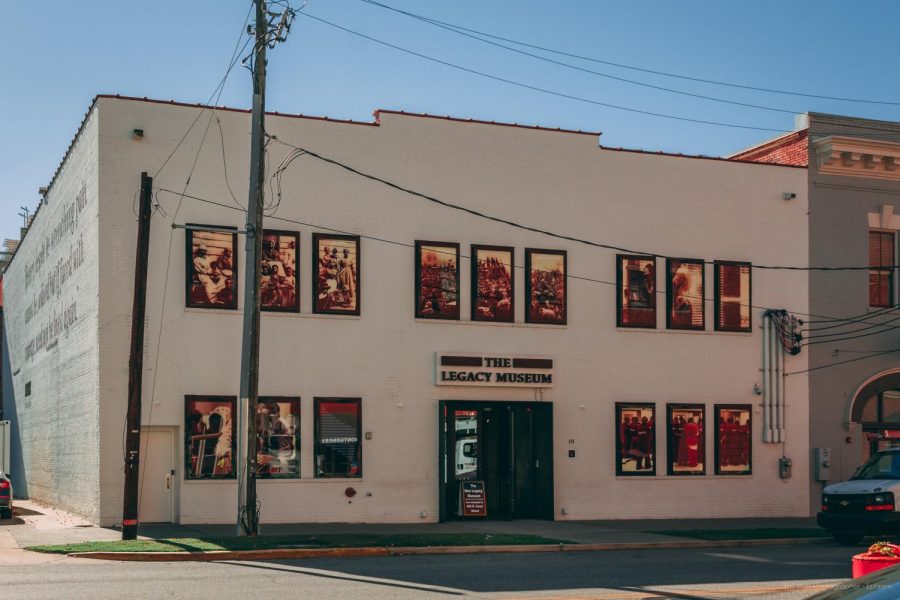The historic significance of the Legacy Museum
PHOTO BY EPHREM TILAHUN/STAFF PHOTOGRAPHER
The Legacy Museum is located at 400 North Court Street in Downtown Montgomery. It displays the history of slavery and racism in America with cutting-edge technology, world-class art and critically important scholarship that portray lynchings and racial bias.
October 16, 2021
The capital of Alabama is a significant place to begin exploring many important enslavement and mass incarceration sites and buildings. The city of Montgomery is home to The Legacy Museum: From Enslavement to Mass Incarceration, located at 400 North Court Street. The museum displays the history of slavery and racism in America with cutting-edge technology, world-class art, and critically important scholarship that portray racial lynchings, segregation, and racial bias.
This remarkable glance into the past allows for students, civilians and tourists alike to gain a comprehensive history of the U.S., focusing on the legacy of slavery and the systems that it generated.
According to a civil rights historic survey done by Montgomeryal.gov, Montgomery’s proximity to the fertile Black Belt region, where slave-owners amassed large, enslaved populations to work the rich soil, elevated Montgomery’s prominence in domestic slave trafficking.
By 1860, Montgomery was the capital of the domestic slave trade in Alabama, one of America’s two largest slave-owning states.
Derryn Moten, Ph.D., chair of the history and political science department at Alabama State University, provided some historical context by noting, “It is important to keep in mind that less than 5% of enslaved Africans ended up in what is today the United States of America. Yet, the legacy of enslavement for those Black persons and their progeny remains with us today. And that legacy includes the Code Noir or Black Codes, segregation and Jim Crow, disenfranchisement, lynching–including “Legal Lynching,” peonage labor, impoverishment, and racism–defined as the belief that “race” accounts for differences in a person’s ability, behavior, and character. Racism also promotes notions of race superiority and racial inferiority. During World War I, the U.S. Army referred to its (all Black) 92nd Division as the “Rape Division,” suggesting that Black men were innately rapists.”
The systematic presentation of these racial ideologies is still present in the modern world, and it shows throughout the disproportionate amounts of African Americans in the U.S. prison system.
“Over 2 million Americans are incarcerated, and a disproportionate number of them are Black and brown men, women, and children,” Moten said. “EJI, Equal Justice Initiative, argues that there is a confluence between “race” and mass incarceration. History shows us that “race” too often determines who is charged and convicted so that a Black person who is convicted of killing a white person is more likely to receive a life sentence or a death sentence than a white person who is convicted of killing a Black person. Since the introduction of the electric chair in the early 20th century in Alabama, only one white person has been executed by the State of Alabama for the murder of a Black person. That white person is Henry Hays, and he was convicted of killing Michael Donald, a Black man from Mobile, Alabama.”
Some students at Alabama State University find it significant to note how The Legacy Museum is built on the same grounds where Black bodies were abused, mistreated, traded as commodities and forced into bondage labor.
“Building the museum here in Montgomery had to be strategic,” said junior public relations major Simone Braves. “This city is so significant to staples of the (American) Civil Rights Movement like the lynchings, bus boycotts, freedom rides, lunch counter sit-ins and more. As a student of an HBCU, one of the main determining factors for choosing a Black college was to be immersed in the culture and develop a deeper understanding of Black history. I have visited the museum twice with friends, and each time I have learned something new about what those who made it possible to be here had to experience.”
“It is no secret that Montgomery, like much of the South, has its hands dirty when it comes to the mistreatment of African Americans,” said sophomore marketing management major Ashanti Mitchell. “Even here on campus, we still have buildings named after known racists. That’s just how deeply rooted racism runs in the South. Having a monument like The Legacy Museum feels like a start at giving voice to those who were lynched and silenced.”
The Legacy Museum: From Enslavement to Mass Incarceration opened to the public on April 26, 2018. It is another aspect of the experience that focuses on the evolution of colonial slavery and how the 13th Amendment created leeway for modern institutionalized slave labor within the U.S. prison system. Within this site, there is information to be seen on convict leasing in the South, which disproportionately affected African American men, the school to prison pipeline, the drug wars of the mid-80s, etc.
“The Mass Incarceration part of the museum stuck with me the most. Seeing how young the men and women who were lynched in the streets and executed by the system is haunting. I recall seeing a display of an 8-year-old boy who was hung from a tree for waving at a white girl,” said Hamad Davis, a senior print journalism major.
Inside, visitors encounter a powerful sense of realism when they enter the museum and confront slave pen replicas, where you can see, hear, and get close to what it was like to be imprisoned awaiting sale at the nearby auction block. First-person accounts from enslaved people narrate the sights and sounds of the domestic slave trade. Extensive research and videography help visitors understand the racial terrorism of lynching and the humiliation of the Jim Crow South. The compelling visuals and data-rich exhibits inside the museum allow visitors to investigate America’s history of racial injustice and its legacy, drawing dynamic connections across generations of Americans impacted by the narrative of racial difference.
“The museum was free of charge when my friends and I visited,” said Mila Davis, a freshman business management major. “Any student of an HBCU should see the horror that is displayed in the museum and take pride in being the product of those broken-down barriers. Although there is still so much work to be done, we have truly come a long way.”







